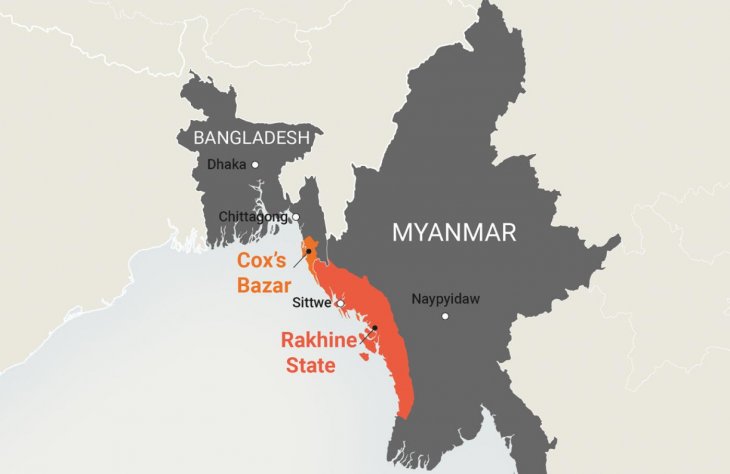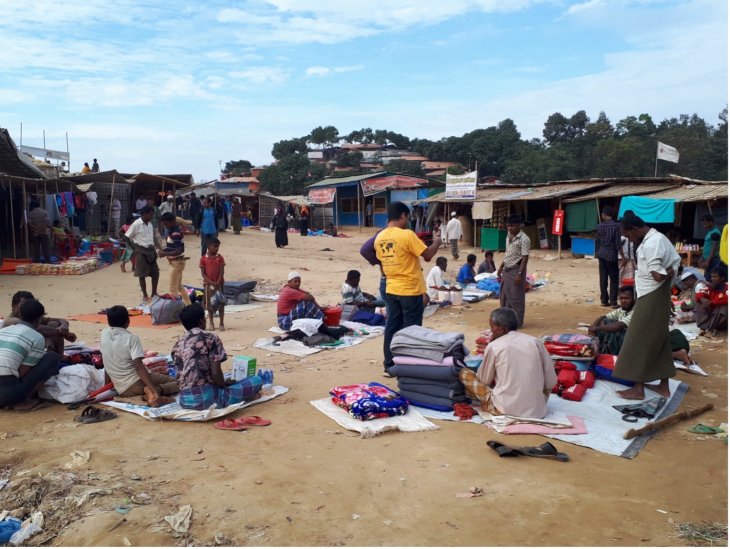The Rohingya are an ethnic group, the majority of whom are Muslim. They have lived for centuries in Myanmar, which is a predominately Buddhist.

Graphic Source: Tove Skjeflo (Norwegian Refugee Council, 2019)
Rohingya struggle
The Rohingya have endured decades of violence, discrimination, and persecution in Myanmar. According to the United Nations High Commissioner for Refugees (UNHCR), nearly a million Rohingya have been forced to leave Myanmar since 2017. More than 960,000 people have found safety in the Cox’s Bazar region of Bangladesh, which is now home to the world’s largest refugee camp (UNHCR, 2022). The vast majority reside in 34 overcrowded camps. This large Rohingya population depends on international humanitarian aid to survive.
Aid dependency and funding crisis in the present global scenario
Soon after the 2017 Rohingya exodus, the world was struck by the COVID-19 pandemic, which was followed by a continuing major conflict in the West (Russia-Ukraine war of 2022). The recent civil war in Sudan, which started in April 2023, will aggravate the global humanitarian aid situation. In this context, donors’ funds are gradually shrinking. Around 36.6% ($322.4 million) of the joint response plan for funding for the Rohingya was unmet in 2022.
Since March 2023, the World Food Program (WFP) has reduced the value of food vouchers from $12 to $10 due to a lack of funding (WFP, 2023). As a result, the UK’s Permanent Representative to the UN in Geneva, Ambassador Simon Manley, during his statement on the 2023 Rohingya Joint Response Plan, emphasized that the Rohingya self-reliance and less dependence on humanitarian aid by ensuring a ‘maximum effect of every penny they spend’ to provide a safe and secure environment for refugees.

A Rohingya Camp, Ukhia, Cox’s Bazar Photo: Mohammad Salehin
There are two general strategies to address the funding crisis: ‘self-reliance’ and ‘effective use of funding.’ While both are essential, this blog post will focus on the former.
Potential Benefits of Income-Generating Activities for Rohingya Stateless People
What will be the future of Rohingya who fled to Bangladesh? – a contentious question with no clear answer.
International organizations like Oxfam, Save the Children, and World Vision suggested to provide income-generating opportunities to Rohingya people. They opined that the lack of income-generating opportunities made Rohingya refugees dependent on aid, making them highly vulnerable to exploitation.
Presently, extremely limited income-generating activities are prevalent in the camp. The Rohingya in the camp produce handicrafts and artworks such as paintings. These products are affordable and attractive; therefore, there is a demand among host communities for Rohingya-made handy crafts. NGOs often act as an intermediary to sell Rohingya crafts so the Rohingya can earn some money.
“If refugee settlements are closed and isolated from the host economy, without access to trade, microeconomic theory suggests that the provision of aid in kind results in a suboptimal allocation of resources” (Alloush et al., 2017). Rohingya camps in Bangladesh are closed and isolated from the host country. We (the authors) argue that the situation will improve if Rohingya have more access to income-generating opportunities. Facilitating income-generating activities in the camp brings multiple benefits:
- The aid dependency of Rohingya will be reduced. Making Rohingya self-reliant should get high attention considering the current situation where international donors are cutting the budget for Rohingya aid.
- Participating in income-generating activities will facilitate learning new skills for the Rohingya people that will serve them well in the future, whether it is in Myanmar (repatriation), in Bangladesh (integration), or in a third country (taking asylum in a developed country).
- According to the media, there are many concerns in the camp area, such as security, fleeing to other countries, internal clashes, and factions. Their uncertain life triggers them to do things they would not do otherwise have done. Providing income opportunities can play a remedial role to these problems.
- A Space for earning can help Rohingya in releasing their traumatic experiences, and they will be able to deal better with frustration and anger.
- If host populations benefit economically from the establishment of Rohingya camps and the operations of humanitarian agencies, they may be more likely to welcome refugees.
Path to self-reliance: Income-generating opportunities within the Rohingya camp
Mobility is limited for the Rohingya living in the camp, primarily because of security issues and other factors. However, restricted mobility doesn’t have to mean a lack of engagement in income-generating activities.
‘Prisoner’ is a widely used example when we talk about the restricted mobility of people. Even prisoners globally are allowed to participate in a variety of income-generating activities. Bangladesh is no exception to this. For example, the Cumilla division (an administrative division) jail authorities have engaged male and female prisoners in various income-generating activities, including exquisite crafting handicrafts such as Nakshi Kantha — a delicate handmade embroidered quilt — among other products. The initiative aims not only to impart valuable skills but also to promote self-reliance among the inmates (Prisoners in Cumilla Jail Spend Productive Time, 2019). Throughout the year, the ‘prison’s sales and exhibition center’ actively sells handicraft products. It is also encouraging to mention that Bangladesh’s first-ever mini-garment factory was established in the Narayanganj jail in 2017 to provide prisoners with income-generating opportunities (RMG Factory in Prison, 2017).

A small Rohingya market inside the camp, Ukhia, Cox’s Bazar. Photo: Mohammad Salehin)
Bringing prisoner examples in this article is not intended to compare Rohingya people with convicted prisoners. Instead, the aim is to illustrate the feasibility of income-generating activities while maintaining security and adhering to current mobility restrictions within the camp.
The government of Bangladesh has already taken some initiatives in Bhashan Char (an Island located in the Bay of Bengal, where 20000 Rohingya were relocated in late 2020) to enhance the livelihood assets of the Rohingya. Other Rohingya camps in Cox’s Bazar are different from Bhashan Char. Bhashan Char is a fertile island with adequate space for farming and fishing, whereas camps in Cox’s Bazar are overpopulated slum areas with limited space. Hence, the Bangladesh government cannot replicate the same in Cox’s Bazar. The government of Bangladesh (GoB) should seriously explore the possibility of introducing economic activities within the Ukhiya camps, enabling Rohingya to engage in income-generating activities without leaving the camp.
If the GoB prefers not to take direct responsibility for implementing income-generating programs in the camps, the GoB has the option to involve NGOs and other third-party organizations. GoB can also collaborate with Refugee-led Organizations (RLOs) or other community-based initiatives within the camps. In this regard, the GoB’s role could be limited to that of policymakers and supervisory, while various development partners could carry out the actual implementation. GoB may establish an overseeing body.
To avoid future conundrums, stakeholders should run some pilot projects before embarking on large-scale programs and public policy. While the GoB should consider facilitating income-generating activities for Rohingya refugees, caution is necessary as projects in refugee camps are challenging in many ways. Formulating and implementing policy on promoting income-generating activities for Rohingya is difficult. Nonetheless, it is crucial to consider that the systematic engagement of Rohingya in income-generating activities will likely have many positive effects, and the positive aspects are anticipated to outweigh the negative ones.
The Authors
- Mohammad Musfequs Salehin: Associate Professor at UiT – the Arctic University of Norway, and Senior Researcher at the Peace Research Institute Oslo (PRIO). mohammad.salehin@uit.no
- Mizanur Rahman: Ph.D. Fellow at the Centre for Peace Studies (CPS), UiT – The Arctic University of Norway. mizanur.rahman@uit.no